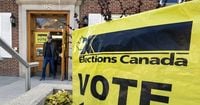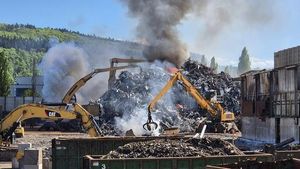Canadians across the country are casting their votes today in a pivotal federal election that will determine not only their next prime minister but also the nation’s response to ongoing tensions with the United States under President Donald Trump. The stakes are high as voters head to the polls to choose between Pierre Poilievre’s Conservatives and Mark Carney’s Liberals, amidst a backdrop of trade wars and economic uncertainty.
On April 28, 2025, polling stations opened nationwide at staggered times, starting as early as 8:30 a.m. NST in Newfoundland and closing as late as 7 p.m. PST in British Columbia. This election follows a tumultuous period marked by the resignation of former Prime Minister Justin Trudeau, the prorogation of Parliament, and the swift rise of Carney, who became the Liberal leader in March 2025.
According to Elections Canada, a record 7.3 million Canadians participated in advance voting during the Easter long weekend, a 25% increase from the previous election in 2021. As voters take to the polls today, they face a tightly contested race that has seen the Liberal Party gain ground in recent weeks, with Carney leading in pre-election surveys.
Trump’s influence looms large over the election. The U.S. president took to Truth Social to urge Canadians to elect a leader who would cut taxes and increase military strength, while also suggesting that Canada could become the 51st state of the United States. His comments have sparked significant backlash, with Poilievre responding, "President Trump, stay out of our election. The only people who will decide the future of Canada are Canadians at the ballot box. Canada will always be proud, sovereign and independent and we will NEVER be the 51st state."
Carney also addressed Trump’s remarks indirectly, emphasizing Canada’s sovereignty and the importance of the upcoming election. The implications of Trump’s tariffs on Canadian goods have been a central issue throughout the campaign, with both parties outlining their strategies to combat the economic fallout.
The Liberal Party, now led by Carney, has positioned itself as the party best equipped to handle the challenges posed by Trump’s administration. Carney, a former central banker, is advocating for economic policies that prioritize stability and growth, particularly in light of the tariffs imposed on Canadian exports, including a 25% tariff on automobiles and steel.
Polling data suggests that the Liberals currently hold a slight lead over the Conservatives, with an average of 42% to 39%, according to the CBC’s poll tracker. In Ontario, the Liberals enjoy a seven-point lead, while in Quebec, that advantage swells to 15 points. This shift in voter sentiment comes after months of political turmoil and economic uncertainty, driven in large part by Trump’s aggressive trade policies and threats.
As voting unfolds, the focus is not solely on the two leading parties. The New Democratic Party (NDP), led by Jagmeet Singh, is also vying for support, particularly in British Columbia, where Singh is scheduled to attend a Day of Mourning event in Burnaby later in the evening. Meanwhile, Bloc Québécois Leader Yves-François Blanchet is campaigning in Quebec, and Green Party co-leaders Elizabeth May and Jonathan Pedneault are engaging with voters in their respective regions.
In British Columbia, the recent tragedy at a Filipino heritage festival, where 11 people lost their lives, has cast a shadow over the election. Singh participated in a vigil for the victims, and many voters are grappling with the emotional impact of the event as they head to the polls.
The election also comes against a backdrop of pressing domestic issues, including rising housing costs and food prices. The Conservatives have proposed GST cuts on new homes under $1.3 million, while the Liberals aim to double homebuilding to 500,000 annually. The NDP is advocating for national rent control and the construction of $3 million homes by 2030.
As Canadians cast their ballots, they are also considering the parties’ platforms on key issues like healthcare, jobs, and food affordability. The Liberals plan to expand dental and pharmacare, while the NDP promises to remove GST from groceries and cap food prices. The Green Party has pledged to invest in local food systems and stop corporate price-gouging.
Polling stations are expected to be busiest during the early morning and evening hours, with voters encouraged to check their identification and ensure they are registered to vote. Elections Canada has implemented measures to assist homeless individuals in the voting process, reflecting the organization’s commitment to inclusivity.
As the results begin to trickle in after polls close, the future of Canada hangs in the balance. With 343 seats in Parliament up for grabs, the party that secures the most seats will form the next government, potentially reshaping the nation’s political landscape for years to come. The outcome will not only reflect Canadians’ preferences for leadership but also their stance on how best to navigate the complexities of international relations and domestic challenges.
In this election, Canadians are not just voting for a party; they are deciding the direction of their country amidst unprecedented external pressures. The implications of their choices will resonate far beyond the ballot box, shaping Canada’s identity and its role on the global stage.






